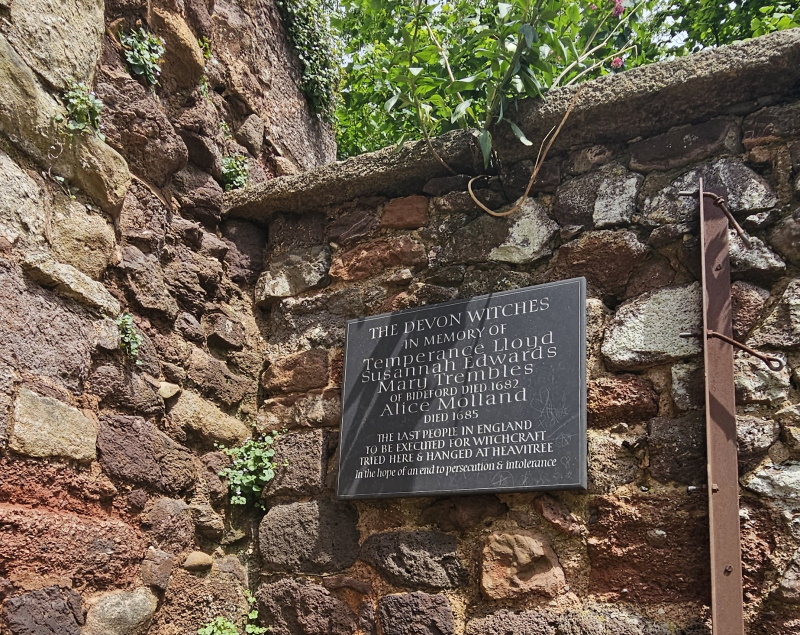Exeter’s 2,000 year history is evident around every corner, with numerous historic buildings and architectural features still standing today. Some are hard to miss, such as the Norman Exeter Cathedral which dominates the skyline of the city centre, but some of the most fascinating constructions are hidden away off the beaten path, yet have fascinating tales to tell! We take a look into some of Exeter’s hidden historical gems…
St Nicholas Priory
St Nicholas Priory is Exeter’s oldest building, located on the narrow Mint Lane, off Fore Street in the city’s West Quarter. Originally founded in 1087 by William the Conqueror as a Benedictine monastery, it later became the home of a rich merchant in the 16th century, which is how it is presented today.
Experience what Tudor life was like by walking through the undercroft and parlour, the medieval kitchen, the Great Hall and bed chamber. The priory is open to visitors free of charge on Sundays 1 – 4pm and Mondays 10am – 4pm.
 small.jpg)
Exeter Catacomb
Constructed in the style of Egyptian tombs, the Catacomb was built in St Bartholomew’s Cemetery between 1835 and 1837. As Exeter's population grew, existing burial grounds became insufficient, and the cholera epidemic of 1832 highlighted the urgent need for new facilities. Designed for the wealthy, the Catacomb provided secure, brick-lined vaults to protect the deceased from grave robbers.
However, due to the high cost of interment, only 14 of the 1,400 available spaces were ever used. Despite their cold and dark atmosphere, the passageways can be explored for free on a Red Coat Guided Tour, part of the ‘Churches, Cemeteries and the Catacomb’ tour. You'll hear fascinating stories about the Catacomb’s varied uses over the years, including its role as a bomb shelter during the Second World War and the tale of the stolen skeleton!
 small(1).jpg)
Exeter Castle
Exeter Castle, also known as Rougemont Castle, has a rich history that dates back to the Norman Conquest of England. Built in 1068 on the orders of William the Conqueror, the castle was strategically located on a hill overlooking the city, providing both defence and dominance over Exeter.
The castle's name, Rougemont, derives from the local red stone used in its construction, giving it a distinctive appearance. Initially, the castle featured a wooden motte and bailey design, typical of Norman fortifications. Over time, the wooden structures were replaced with stone, creating a formidable stronghold.
Throughout its history, Exeter Castle played a significant role in various historical events. A plaque by the gatehouse commemorates Temperance Lloyd, Susannah Edwards, Mary Trembles, and Alice Molland, who were tried for witchcraft at Exeter Castle. Found guilty, they were the last people in England to be executed for this crime. They were hanged at Gallows Cross in Heavitree in 1682 and 1685, respectively.

After its surrender to General Fairfax in 1646, this once formidable castle ceased to be a military fortress, and it gradually transitioned to a more administrative role, housing courts and local government offices. There are still extensive remains of the boundary walls of the castle enclosure and early towers to East and West, best viewed from Rougemont and Northernhay Gardens.
Today, Exeter Castle grounds play host to a year-round calendar of events, including food and music festivals.
Stepcote Hill
Located in Exeter’s West Quarter, this steep, cobbled street is one of the oldest surviving parts of Exeter, famed for its quaint, half-timbered houses, some dating back to the 15th and 16th centuries. It was once the main route into Exeter from the river, used by strings of pack horses and weary travellers, before New Bridge Street was constructed in 1778.
Later in the 19th century, the street was afflicted with bouts of cholera, due to the lack of proper sewerage. Inhabitants would dispose of their waste into the trough in the centre of the street, where the next rain would wash it down towards the river.
According to Hoskins the name itself derives from the Anglo-Saxon word 'stype', meaning 'steep', and even today it remains the steepest route into the city. 'Cote' probably comes from the Anglo-Saxon word for an enclosure. It's recorded c.1270 as Styppecotehyll.
 small.jpg)
The House That Moved
At the bottom of Stepcote Hill you’ll find the ‘House That Moved’. This timber-framed Tudor house quite literally moved from its original location in 1961 when the entire street it was on was demolished to make way for a new bypass road linked to the replacement of the city's bridge over the River Exe. The building was stripped to its frame, windows removed, then protected by a timber casing. The entire building was jacked up and set on metal wheels, then moved to its current location at the bottom of West Street!
Also on West Street is St Mary Steps Church which has a well-known historic clock, renowned for its striking automaton figure of Matthew the Miller, who marks the hours by striking the bell with his flail.
 small.jpg)
Medieval Exe Bridge
The old Exe Bridge in Exeter is a remarkable relic of medieval engineering, with its origins dating back to the late 12th century. Commissioned by Nicholas Gervaise, a prominent local merchant, and completed around 1238, the bridge was one of the earliest stone arch bridges in England. Spanning the River Exe, it featured 17 arches and extended over 600 feet, serving as a critical connection between the city of Exeter and the western parts of Devon. The bridge's construction was an impressive feat of medieval engineering, designed to withstand the river's powerful currents and the seasonal flooding that often plagued the area.
 small.jpg)
Over the centuries, the old Exe Bridge not only facilitated trade and travel but also became a bustling hub of community life. It was lined with buildings, including houses, shops, and even a chapel dedicated to St. Edmund, giving it a vibrant, almost village-like atmosphere. However, the bridge's fortunes declined in the 18th and 19th centuries due to the changing needs of transportation and the construction of newer, more modern bridges. By the early 20th century, much of the original structure had been demolished or buried. Today, the remaining arches of the old Exe Bridge are preserved as a historical monument, offering a glimpse into Exeter’s medieval past and its architectural heritage.
Exeter Canal
The Exeter Ship Canal holds a significant place in the maritime history of Exeter. Its origins date back to the 16th century, making it one of the oldest artificial waterways in England.
The canal was conceived as a solution to a pressing problem: the River Exe had become increasingly difficult to navigate due to the buildup of sandbanks and the actions of the Countess of Devon, Isabella de Fortibus. She had constructed a weir across the river to power her mills, leaving only a 30-foot gap for passage.
In 1311, her successor, Hugh de Courtenay, completely blocked this gap, cutting off Exeter from the sea entirely. Ships were then forced to dock at Topsham, pay dues there, and use the Courtenay warehouses, leaving Exeter's warehouses empty and unused. Despite endless legal arguments, the situation remained unchanged until an Act of Parliament in 1540 allowed Exeter to reopen the river.
However, by this time, the river was so silted up that even the smallest vessels struggled to reach the Quay. The proposed solution to this problem was the construction of a canal, which began in 1563 under the direction of John Trew, a notable engineer of the time.
The initial stretch, completed in 1566, was a modest three-mile section that connected the city to the tidal reaches of the River Exe at Turf. This early canal featured an innovative design for its era, including a set of locks to manage water levels, which was a pioneering feature in canal engineering. The Exeter Canal quickly became a vital artery for trade, enabling ships to bypass the obstructions in the river and directly access the bustling port of Exeter.
The canal underwent significant expansions and improvements in subsequent centuries. In the 17th century, it was extended to Topsham, and in the early 19th century, a major overhaul saw it widened and deepened to accommodate larger vessels. These enhancements were crucial in maintaining Exeter's economic vitality, particularly during the industrial revolution, when the efficient transport of goods became even more critical.
Today, the Exeter Canal is a cherished historical landmark and a popular leisure destination. Its tranquil waters and scenic surroundings attract boating enthusiasts, anglers, and walkers, offering a glimpse into the rich industrial heritage of the region.
The canal and basin were granted Heritage Harbour status by the Maritime Heritage Trust and National Ships UK in 2021, and an annual Heritage Harbour Festival celebrates this status and the city’s maritime history!
 small.jpg)
Related
Comments
Comments are disabled for this post.



 to add an item to your Itinerary basket.
to add an item to your Itinerary basket.





